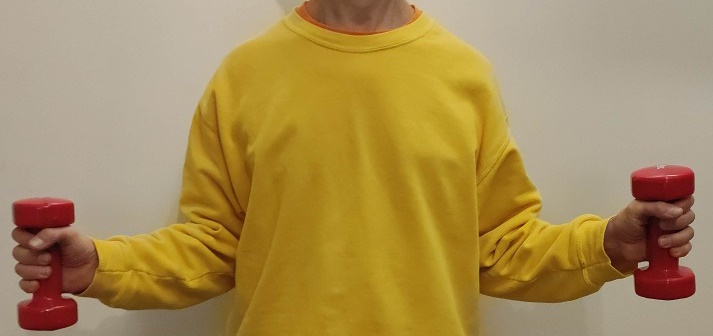yogabook / functional exercises / passive scapular depression with dumbbells

Passive scapular depression with dumbbells
Feedback: We’d love to hear what you think about this description, give us feedback at:
postmeister@yogabook.org
last update: 30.10.2023
Level: A
- Classification
- Contraindication
- Effects
- Preparation
- Follow-up
- derived asanas
- similar asanas
- Diagnostics
- Instructions
- Details
- Variants
Instructions
- Stand upright, one dumbbell in each hand, not too heavy
- bend the elbow joints to 90° and move the forearms into a mid-position between pronation and supination to hold the barbell still in this position. The shoulder blades are depressed in accordance with gravity and the elbows lie loosely against the upper body, while the arms are turned out so far that the forearms point outwards by approx. 20-30° on both sides against the parallel position.
Details
- The middle position of the forearms between pronation and supination ensures that the wrists do not fall into palmar flexion or dorsiflexion due to gravity, i.e. the corresponding muscles are not challenged. Only the corresponding muscles of the radial abductors, i.e. primarily flexor carpi radialis, extensor carpi radialis brevis and extensor carpi radialis longus, have to work against the gravity-induced moment in the direction of ulnar abduction. This means that the exercise can usually be performed well even with golfer’s elbow or tennis elbow. If there is still discomfort associated with one of these disorders, the exercise can be varied until this is no longer the case. Except in the case of simultaneous presence of golfer’s elbow and tennis elbow, it should be possible to find a pain-free position.
- The arms must not be rotated so far that a tendency to cramp occurs in the exorotators. This applies all the more if the ability to exorotateis limited and a certain amount of force is required to reach the specified 20-30°.
- If a golfer’s elbow is present, especially one of the finger flexor type, the dumbbell should be placed with the upper head resting firmly on the index finger and thumb so that less grip strength is required to maintain the dysfunction. Extending the forearm in the direction of pronation can trigger the pain known from tennis elbow, and that in the direction of supination that of golfer’s elbow.
